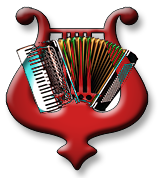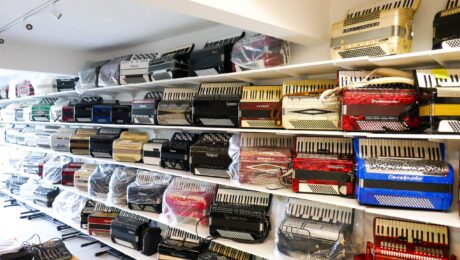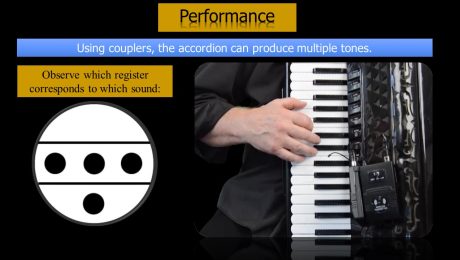Understanding the Different Types of Accordions
Accordions belong to the reed family of instruments and are bellow driven. The origin of the accordion can be traced back to the 1800s where they were first played as diatonic accordions. Today, however, we can enjoy the instrument in many different styles and key-note systems. Listed below are the main types of generic accordions and their specifications to help you brush up your knowledge and make an informed buying decision.
Diatonic Accordions
Made in the early 1800s, these accordions consisted of one row of 10 buttons on the right hand. For every note on the button board, there are a minimum of two reeds present with different pitched reeds for both “in” and “out” bellows. Relevant chords and bass notes are the foundation of the bellows and the fifth of “out” bellows’ scale. The diatonic accordions can be further divided into:
- Single row diatonic
- Two row Diatonic
- Three row Diatonic
- Organetto
- Italian Diatonic
- Shand Accordion
- Helikon Diatonic
Diatonics are typically used by dance and folk groups thanks to their brilliant sound output, light weight, simplicity and low cost. All these qualities make the diatonic accordion popular worldwide. The note pattern of the instrument is rather identical to that of a harmonica.
Concertinas
Concertinas have a distinct design, ranging from 4 to 12 sides (in cross section). This type of accordion has two keyboards, one at each end of the bellows. Fixed chords are absent and all the buttons have individual notes. The number of systems and notes differ significantly that an accordionist of one system will find it difficult to grasp the technicalities of a different system, and will certainly need to learn it from scratch.
Every side of the concertina has a thumb, finger or wrist wrap for ease of use and is normally held up against the knee. Because it is so compact and lightweight, this type of accordion makes for a great choice for visual entertainment since players can move around easily. There are several different types of concertina accordions:
- English Concertina
- Chemnitzer (German Concertina)
- Duet Concertina
- Anglo-German Concertina
- Bandoneon
Chromatic Accordions
First created by F. Walter in the 1850s, the chromatic accordion was the result of the rearrangement of the Three Row Diatonic reeds. Although the chromatic is no more a diatonic accordion, but still has an incredibly wide range of treble notes available today. The sizes range from 12 bass buttons and 20 treble keys to 160 bass buttons and 6 strings of treble keys. The chromatic keyboard consists of more than one system, and can have 3 to 6 rows of keys. The 4th and 5th rows are replicas of the first 3 rows, for increasing the possibilities of fingering.
The layouts can be divided into two primary types: B and C systems, where the B system is ideal for technically complex works, while the C system offers much easier control of the chords to help you play melodic music better. The bass system can be free bass, stradella (normal bass) or a combination of the two (convertible system). The chromatic is most popular in Russia, where it is commonly referred to as the Bayan.
Button Accordions
Button Key Accordions work by pressing a set of buttons whilst the player expands and contracts the instrument. These are used widely and involve a variety of differently set keys and buttons, allowing users to easily move their fingers and reach more notes without having to stretch their hand much.
Moreover, many notes have duplicates, which offer more substitute options for fingering. The hand can easily reach more than two octaves without moving it and fingering patterns stay steadier. The buttons are upright and each row plays a major scale, which means if the player wishes to play more than one scale, he or she will have to play buttons in different rows.
Piano Key Accordions
The piano keyboard was originally made part of an accordion in 1852 in Paris by Bouton. It continued to go unrecognized until the early 1900s, but the real developmental phase came in 1910 and onward when the instrument became prominent almost worldwide. Piano accordions are most popular in the US and the UK and have a similar style to that of a piano or keyboard instrument. This type of accordion comprises of a piano type keyboard for the right hand and bass accompaniment with a field of buttons for the left hand.
A full-size piano accordion features 120 bass buttons and 41 treble keys, and ranges from a low “f” to a high “A”. This accordion facilitates quick pick up and addition of the bass as the bass chords and notes for a precise key are normally huddled close together. A hit on a range of bass notes makes it easy for the player to locate a note just by feeling it. The suggested professional size is 120 bass and 41 treble notes, but you can always opt for smaller versions with different sounds and notes that best fit your needs.
Piano reeds are virtually the same as a chromatic accordion, apart from its design, keyboard notes and the overall layout of the keyboard. Thanks to its universal note system, the popularity of the piano accordions has far exceeded that of button accordions from the early 1920s until today.
Reedless Accordions
Also known as digital accordions, reedless accordions are handy instruments which produce an authentic accordion sound even in the absence of reeds. This accordion type offers a big benefit to accordionists who find it difficult to manage the heavy weight of a standard accordion and are ideal for public entertainment. In a digital accordion, sound is produced with the help of electronics, and the result is crisp, high quality sound with transparent bass.
- Published in accordion, Buying an accordion, choosing your accordion
How to choose an accordion
The accordion has registers that allow different timbres thanks to the combinations of reed stops. It is important to understand these registers to choose your accordion. (more…)
- Published in accordion, Buying an accordion, choosing your accordion, knowledge


